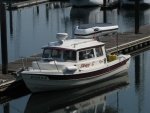fortress anchors are best deployed with plenty of heavy chain, in my experience.
I understand that some have had mixed results with plow anchors, and I agree they are not the most likely to hold in all bottom types, however the plow in and of itself does not skip lightly across the surface. Anyone who has ever run a plow behind a horse will tell you that the plow wants to dig and and stop very very badly. It's the operator that keeps the angle of the plow just right so it doesn't "SET" and instead "SKIMS" as it's pulled by the horse. They are not inherently flawed because they are a plow and plows skim.
This operation is achieved by controlling the point of the plow and keeping it directed upward slightly, enough to move the earth but not enough to set. Again, like the fortress, the opposite (the plow SETTING) is accomplished with a plow type anchor by having plenty of scope out, and having plenty of chain. So if the chain sets on the bottom at a nice acute angle and the portion of the chain attached to your anchor never lifts off the bottom, your plow will never lift upward, and should hold reliably. If when there is sufficient current, insufficient chain, or insufficient scope, such that the chain is being pulled upward at the anchor it will certainly drag. If it stays down, it should hold.
When I fish I will often, if not always fish with barely more scope out than the dept. Usually 1.5:1 in somewhere between 100 and 200' of water. We have some big currents here, and I usually hold just fine. I would not trust this setup, or use it in a situation where I had to hold fast, or wasn't able to pay attention and correct drag, but your anchor can and will hold even if your rode is vertical (ask anyone who has gotten an anchor stuck!).
I'm only going into it like this because there was some advice that 3:1 is fine, and it can be, but it all depends on conditions, bottom, etc. I've held for hours with less than 3:1, even swung around on tide turns no problem, but I've also dragged. If I were learning to anchor I'd start with plenty of rode and then see what I could get away with in terms of shortening it.

